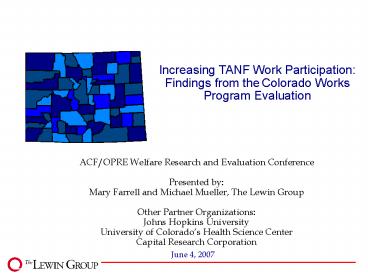Increasing TANF Work Participation: - PowerPoint PPT Presentation
1 / 17
Title:
Increasing TANF Work Participation:
Description:
Colorado contracted with Lewin to evaluate Colorado Works, Colorado's ... Demetra Nightingale (Co-PI) Johns Hopkins University. 401-516-8796. dnight_at_jhu.edu ... – PowerPoint PPT presentation
Number of Views:952
Avg rating:3.0/5.0
Title: Increasing TANF Work Participation:
1
Increasing TANF Work Participation Findings
from the Colorado Works Program Evaluation
ACF/OPRE Welfare Research and Evaluation
Conference Presented by Mary Farrell and
Michael Mueller, The Lewin Group Other Partner
Organizations Johns Hopkins University University
of Colorados Health Science Center Capital
Research Corporation
June 4, 2007
2
Evaluation
- Colorado contracted with Lewin to evaluate
Colorado Works, Colorados TANF program - Partners
- University of Colorados Health Science Center
- Johns Hopkins University
- Capital Research Corporation
- In 3rd year of 5-year study
- Examining potentially promising self-sufficiency
strategies and approaches - Advisory Committee and State oversees evaluation
and selects topics to be addressed - One topic selected Work Participation
3
Work Participation Study
- Reviewed literature and TANF regs
- Reviewed recommendations of Colorado Works
Work Participation Task Force - Contacted 20 of 64 counties to understand
approaches and strategies being pursued - Analyzed Colorado Works participation data
4
Caseload decline in Colorado 62 from 1995 to
2006
Source ACF AFDC/TANF reports
5
Adjusted All Families WPR Set to 0 for
All-Families Rates FY99 - FY06 Could increase to
50 in FY07
6
Strategies Pursuing to Increase Participation
- Wide-ranging differences in philosophies
regarding how best to respond to DRA - Strategies promoted by State and Task Force
- Up-front/Intake State Diversion Provides
diversion during initial intake/ assessment
period when clients are not participating in
countable activity - Refinance Payments Not claiming county
appropriated funds as state MOE instead using
these funds for two-parent cases and
hard-to-employ individuals (taking them out of
equation) - Active Case Management More vigilant management
of case activities (assessing clients, moving
them into activities quickly, sanctioning, and
using data reports effectively)
7
Other Strategies Highlighted by Counties
- Financial incentives and post-employment
diversion - Expanded use of case closures for demonstrable
evidence - Close tracking of participation reports from
state system - Having specialized case managers
- Holding staff and contractors accountable for
meeting rates
8
Participation Status of Adult TANF Recipients
(10/05)
Note Calculation differs from WPR calculation
significantly. Disregards included in this
denominator, and not in WPR calculation. Also,
calculation is of adults, not cases. Source CBMS
9
Demographics of Adult TANF Clients by
Participation Status (10/05)
10
Main Differences in Characteristics
- Meeting all families rate
- Never married
- Younger
- Youngest child under age 6 (face 20 hour
requirement) - Participating, but for fewer hours than required
- Youngest child 6 years or older (face 30 hour
requirement) - Not participating, not exempt
- Fewer months on TANF clock (perhaps new to TANF
system and not yet assigned to activity) - May have barriers not yet identified
- Exempt due to disability or caring for disabled
- Substantially older
- More months on TANF clock
11
Percent of Participants in Work Activity (10/05)
Note Participants can participate in more than
one activity thus percents sum to more than 100
12
Percentage of Participants Meeting the All
Families Rate by Primary Activity (10/05)
Primary activities are defined as those in
which clients has 2/3 of their countable
hours Includes Work Experience, Community
Service, OJT and Subsidized Employment
Includes Job Skills Training, Education Directly
Related to Employment and Vocational Educational
Training
13
Leaver Status After 12 Months by Participation
Status in 10/05
14
Preliminary Conclusions
- Substantial portion of clients meeting work
participation subject only to 20 hour requirement - Many adult recipients (10 percent) are
participating but not meeting the hours
requirement - Non-participants with no hours more likely to be
new to TANF (takes time to move clients into
activities) - Up-front/intake diversion might help state meet
WPR - Non-participants also more likely to exit TANF
and not return
15
Still to Come
- Work Participation Study
- Compare FY06 (pre-DRA) rates by county to FY07
and F08 rates - Survey county directors and visit selected
counties to understand how counties implemented
new policies - Examine TANF receipt and UI wage outcomes after
diversion - Tie specific strategies employed (e.g., enhanced
case management, up-front diversion, non-TANF
funding) to changes in participation rates over
time - Conduct statistical analysis of factors,
including policies and economic conditions,
associated with participation
16
Other Components of Evaluation
- Leavers Study (client survey and administrative
data analysis) - Caseload Modeling Study (examine factors behind
recent caseload reduction) - Longitudinal Data Analysis
- Comparative Study
- Other Topical Studies as selected by Advisory
Committee and State
17
For Further Information
- Contact
- Mary Farrell (Project Director)
- The Lewin Group
- 703-269-5685
- mary.farrell_at_lewin.com
- or
- Demetra Nightingale (Co-PI)
- Johns Hopkins University
- 401-516-8796
- dnight_at_jhu.edu































